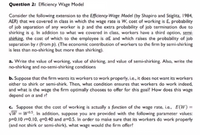Question 2: Efficiency Wage Model Consider the following extension to the Efficiency-Wage Model (by Shapiro and Stiglitz, 1984, AER) that we covered in class in which the wage rate is W, cost of working is E, probability of job separation of any worker is p and the extra probability of job termination due to shirking is q. In addicion to what we covered in class, workers have a third option, semi- shirking, the cost of which to the employee is aE and which raises the probability of job separation by r (from p). (The economic contribution of workers to the firm by semi-shirking is less than no-shirking but more than shirking). a. Write the value of working, value of shirking, and value of semi-shirking. Also, write the no-shirking and no-semi-shirking conditions b. Suppose that the firm wants its workers to work properly, i.e., it does not want its workers either to shirk or semi-shirk. Then, what condition ensures that workers do work indeed, and what is the wage the firm optimally chooses to offer for this goal? How does this wage depend on a and r? c. Suppose that the cost of working is actually a function of the wage rate, i.e., E(W)= VW = w05, In addition, suppose you are provided with the following parameter values: p=0.10 r=0.10, q=0.40 and a=0.5. In order to make sure that its workers do work properly (and not shirk or semi-shirk), what wage would the firm offer?
Question 2: Efficiency Wage Model Consider the following extension to the Efficiency-Wage Model (by Shapiro and Stiglitz, 1984, AER) that we covered in class in which the wage rate is W, cost of working is E, probability of job separation of any worker is p and the extra probability of job termination due to shirking is q. In addicion to what we covered in class, workers have a third option, semi- shirking, the cost of which to the employee is aE and which raises the probability of job separation by r (from p). (The economic contribution of workers to the firm by semi-shirking is less than no-shirking but more than shirking). a. Write the value of working, value of shirking, and value of semi-shirking. Also, write the no-shirking and no-semi-shirking conditions b. Suppose that the firm wants its workers to work properly, i.e., it does not want its workers either to shirk or semi-shirk. Then, what condition ensures that workers do work indeed, and what is the wage the firm optimally chooses to offer for this goal? How does this wage depend on a and r? c. Suppose that the cost of working is actually a function of the wage rate, i.e., E(W)= VW = w05, In addition, suppose you are provided with the following parameter values: p=0.10 r=0.10, q=0.40 and a=0.5. In order to make sure that its workers do work properly (and not shirk or semi-shirk), what wage would the firm offer?
Oh no! Our experts couldn't answer your question.
Don't worry! We won't leave you hanging. Plus, we're giving you back one question for the inconvenience.
Submit your question and receive a step-by-step explanation from our experts in as fast as 30 minutes.
You have no more questions left.
Message from our expert:
Hi and thanks for your question! Unfortunately we cannot answer this particular question due to its complexity.
We've credited a question back to your account. Apologies for the inconvenience.
Your Question:
Please solve step by step.

Transcribed Image Text:Question 2: Efficiency Wage Model
Consider the following extension to the Efficiency-Wage Model (by Shapiro and Stiglitz, 1984,
AER) that we covered in class in which the wage rate is W, cost of working is E, probability
of job separation of any worker is p and the extra probability of job termination due to
shirking is q. In addicion to what we covered in class, workers have a third option, semi-
shirking, the cost of which to the employee is aE and which raises the probability of job
separation by r (from p). (The economic contribution of workers to the firm by semi-shirking
is less than no-shirking but more than shirking).
a. Write the value of working, value of shirking, and value of semi-shirking. Also, write the
no-shirking and no-semi-shirking conditions
b. Suppose that the firm wants its workers to work properly, i.e., it does not want its workers
either to shirk or semi-shirk. Then, what condition ensures that workers do work indeed,
and what is the wage the firm optimally chooses to offer for this goal? How does this wage
depend on a and r?
c. Suppose that the cost of working is actually a function of the wage rate, i.e., E(W)=
VW = w05, In addition, suppose you are provided with the following parameter values:
p=0.10 r=0.10, q=0.40 and a=0.5. In order to make sure that its workers do work properly
(and not shirk or semi-shirk), what wage would the firm offer?
Knowledge Booster
Learn more about
Need a deep-dive on the concept behind this application? Look no further. Learn more about this topic, economics and related others by exploring similar questions and additional content below.Recommended textbooks for you


